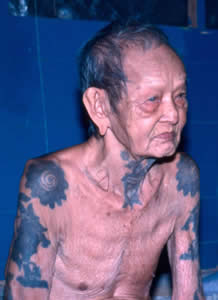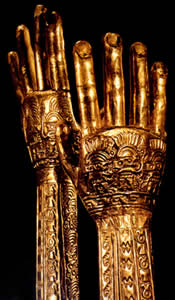Shamanism, Blood Sacrifice, and Tattoos
For millennia, nearly all indigenous
people who tattooed practiced shamanism
which is the oldest human spiritual religion
born at the dawn of time. Death was the
first teacher, the edge beyond which life
ended and wonder began. Shamanistic religion
was nurtured by mystery and magic, but it
was also born of the hunt and of the
harvest, and from the need on the part of
humans to rationalize the fact that they had
to kill that which they most revered:
plants, animals, and sometimes other men who
competed for resources or whose souls
provided magical benefits.
Mythology developed out of these
associations as an expression of the
covenant between humans, their environment,
and everything contained within it. But more
importantly, it was a means of eliminating
the guilt of the hunt, whether human or
animal, and maintaining a certain essential
balance between the living and the spirits
of the dead. After all, shamanism is
animism; the belief that all life - whether
animal, vegetable, or human - is endowed
with a spiritual life force. Spirits living
in these objects were always propitiated and
never offended. Sacrificial offerings,
especially those made in blood, were like
financial transactions that satisfied
spirits because they were essentially "paid
off" for lending their services to humankind
or to satisfy debts like infractions of a
moral code which most indigenous peoples
around the world observed. For example, the
heavily tattooed Iban of Borneo respect adat
or the accepted code of conduct, manners,
and conventions that governs all life. Adat
safeguards the state of human and spiritual
affairs in which all parts of the universe
are healthy and tranquil and in balance.
Breaches of adat disturb this state and are
visited by "fines" or contributions to the
ritual necessary to restore the balance and
to allay the wrath of individuals, the
community, or of the deities. Traditionally,
such rituals included the sacrifice of a
chicken, pig, or in special instances even
another human - especially when a new
longhouse was built.
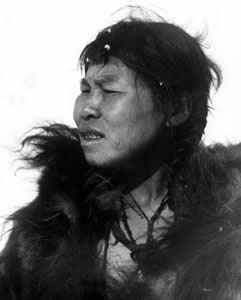 |
|
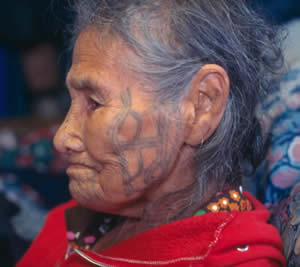 |
|
Chukchi woman with three fertility
tattoos on cheek and a cruciform
tattoo foil marking the corner of
her mouth that was intended as a
charm against evil spirits. Foils
were also stitched into living skin
if the individual had been in great
danger and had escaped. After the
death of a near relative, the
Chukchi also fastened a single bead
to a lock of hair to repel the
"spirits of disease." Chukchi
warriors who had killed other men
sometimes tattooed anthropomorphic
stick-figures on their shoulders in
hopes of capturing the soul of their
victim, thus transforming their
"foe" into an "assistant" or even
into a part of himself. Photograph
ca. 1900. |
|
Qayaghhaq, one of the last
completely tattooed St. Lawrence
Island ooing, "We did it to be
beautiful, so that we would not look
like men. We wanted precious
pictures for the afterlife." She
also wears a set of three fertility
tattoos on her outer cheek and qilak
or "heavens" tattoos near the ear.
Beautifully executed tattoos such as
these were believed to lure game
animals near. In turn, they brought
into the house a part of the sea and
along with that, part of its animal
and spiritual life. Photograph ©
Lars Krutak 2009-1997 |
Perhaps the most common and important
blood sacrifice practiced by many tattooing
cultures worldwide was headhunting: the
taking of human heads for ritual use. Human
blood, the fertilizing essence of everything
animate, was a highly revered sacred
substance believed to appease spiritual
powers that controlled the forces of nature.
Among the prehistoric and tattooed peoples
of ancient Peru like the Moche, Tiwanaku,
and Chimú, ritually prepared human heads
were perceived as potent sources of power to
be harnessed and tapped in order to promote
agricultural fertility and relations with
the ancestral dead and deities. Analogs
drawn from historical headhunting cultures
of India, Borneo, the Philippines, Taiwan,
China, and Brazil also support this model;
because the ritual taking of human heads in
these places was accomplished to ensure both
biological and agricultural fertility, among
other magical advantages.
Apart from their role as the guardians of
tribal religion, some shamans actively
participated in tattooing traditions
themselves. Among the Paiwan of Taiwan, the
Chukchi of Siberia, and the Yupiget of St.
Lawrence Island, Alaska, female tattoo
artists - who were usually shamans - worked
via supernatural channels to cure their
patients of "soul-loss" which was
attributable to disease-bearing spirits that
could be either human or animal. Sometimes
proper treatments included the application
of medicinal tattoos at particular points on
the body or "tattoo foils" to disguise the
identity of the sufferer from such
malevolent entities. Of course, the Chukchi
and Yupiget also tattooed fertility stripes
on the cheeks of barren women or stick-like
anthropomorphic "guardian" markings on the
foreheads of men and women to harness
ancestral powers. In all cases, Paiwan,
Chukchi, and Yupiget shamans were proactive
in rearticulating the surfaces of their
patient's bodies by multiplying its
inscriptions and reinscribing its parts. But
the perceived efficacy of these treatments
was not only confined to the technical or
performative aspects of the tattoo
application itself - although the tattoo
pigments used by the Yupiget were considered
to be "magical" and evil spirits were afraid
of them. Rather, the shaman's power arose
from helper and ancestral spirits who
communicated their magical and curative
powers through her.
Not all tribal tattooists were shamans,
however, because some were simply
traditional healers who had particular
specializations (e.g., eyes, ears, throat).
In the northern Philippines, tattoo artists
tattooed markings on the throats of patients
suffering from goiter or other markings on
the backs of individuals plagued by skin
disorders. Yet many tribal tattooists did
work under the guidance and protection of
one or more spiritual helpers like Kayan
tattooists in Borneo who were always female.
In these instances, some tattoo artists were
like shamans in that they employed methods
of spiritual and physical medicine to "cure"
their patients of serious conditions. The
Kayan tattooed a design called lukut or
"antique bead" on the wrists of men to
prevent the loss of their soul. When a man
was ill, it was supposed that his soul had
escaped from his body, and when he recovered
it was believed that his soul had returned
to him. To prevent the soul's departure, the
man would "tie it in" by fastening round his
wrist a piece of string on which was
threaded a lukut within which some magic is
considered to reside. Obviously, the string
can get broken and the bead lost so the
Kayan replaced it with a tattooed bead motif
that has come to be regarded as a charm to
ward off all disease.
Interestingly, the Kalinga of the
Philippines have a related belief. When
blood is inadvertently drawn in the village,
including that which flows during a
tattooing session, a sipat gesture is made.
The sipat is similar to an exchange of peace
tokens, and begins with the sacrifice of a
chicken whose blood is rubbed near the
injured body part. A brief chant is given to
ward off any evil spirits, and then a red
carnelian bead (arugo) on a string is placed
around the wrist of the person who was
injured. This bead is also a protective
device against malevolent spirits; it "pays
off" any spirit in the vicinity. The
Mentawai of Siberut Island also wear
intricate bead tattoos on the backs of their
hands. One man told me that these permanent
beads "tied-in" his soul to the body but
that they also made him more skillful
whenever he needed to use his hands to
perform various tasks. It should be noted
that the Mentawai people are one the most
profusely tattooed people living today and
the reason for this, they say, is that their
beautifully adorned bodies keep their souls
"close" because they are pleased by
beautiful things like beads, flowers,
sharpened teeth, facial paint, and above all
tattoos (titi).

Before the advent of modern
medicine, many Kalinga women of the
Philippines had small marks tattooed
on their necks to cure goiter. Fagki
wears these marks but she also
suffers from the affliction.
Photograph © Lars Krutak 2009-2007 |
|
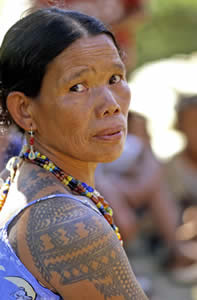 Of all Kalinga tattoo motifs, centipedes and python scales seem to dominate. Both creatures were considered "friends of the warriors" (bulon ti mangayaw) and are believed to be earthly messengers of the most powerful Kalinga deity Kabunian - the Creator of all things. Many women proclaimed that their skin didn't wrinkle if fortified with these designs and that their beautiful body tattoos increased their fertility. Other tattoos were also natural symbols derived from nature. XXX's represent rice bundles and /\/\/\'s are the steps of rice terraces. Some women were tattooed with "necklaces" to appear permanently beaded and beautiful.
Photograph © Lars Krutak 2009-2007 |
Tattooing Techniques and Magical Referents
Tattooing has always been a creative process and depending on local environmental and cosmological forms and meanings, tattooing techniques were quite varied. In Papua New Guinea and other insular regions of Southeast Asia like the Philippines and Taiwan, lemon or orange thorns were utilized in hand-tapping tools; whereas in Polynesia hand-tappers preferred comb-like instruments forged from animal bones. In Sub-Saharan Africa, groups like the Makonde practiced skin-cut tattooing by carving designs into the living flesh with iron tools made by the blacksmith and then rubbing-in carbon pigments derived from the castor bean plant. The Native peoples of the Northwest Coast of North America like the Haida and Tlingit used hand-poking tools probably derived from Japanese sources although they are much smaller in scale. Each pigment brush was carved with a crest animal that imparted supernatural protection to the design thus created. Other indigenes like the Ainu of Japan and several Native American groups in California like the Hupa preferred obsidian lancets with which to slice open the skin; afterwards a sooty pigment was rubbed into the raw wounds until the skin felt like it was "on fire." Both groups practiced medicinal forms of tattooing and also more supernatural forms aimed at blocking evil spirits from entering the orifices of the body. Amazonian groups preferred various varieties of palm thorns to prick-in their tattoos, while the pre-Columbian Chimú seemingly skin-stitched their tattoos with animal bone or conch needles attached to sinew or vegetable threads - such tools have been found in mummy bundles.
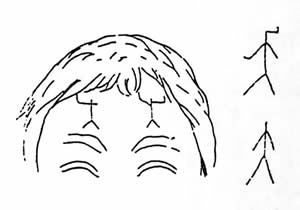
"Guardian" or "assistant"
tattoos. In the Siberian Yupik
language these marks are called yugaaq or "powerful person" and
recall an ancestral presence.
Drawing ca. 1900.
|
|
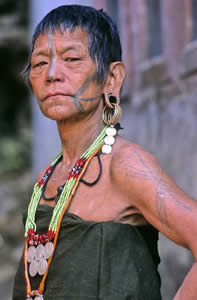 |
|
A Laju Naga women
living in Arunachal Pradesh, India
reported that, "My ancestors will
only recognize me after I die
because of my tattoos." Photograph ©
Lars Krutak 2009-2008. |
The technique of skin-stitching was also practiced by more northerly Arctic peoples like the Yupiget, Chukchi, and Inuit until the early 20th century: a practice believed to be over 2,000 years-old. Tattooing here was always performed by women and tattooing in the traditional manner required extensive knowledge of animal products, pigments, and natural substances suitable for indelible marking. In the Yupiget and Chukchi areas, Lampblack was the primary pigment used to darken the sinew thread because it was believed to be highly efficacious against "spirits." However, fine dark graphite (tagneghli) was also used. Tagneghli was a magical substance obtained through barter in Siberia, and it was considered to be the "stone spirit" which "guards" humankind from evil spirits and from the sicknesses brought by them. Traditionally, it was used to protect village children from the possessive spirits that were "awakened" as a result of a recent death in the village. Lampblack or graphite was then mixed with urine (tequq) because it was also considered to be an apotropaic substance suitable for tattooing, perhaps because it came from the bladder: an organ believed to be one of the primary seats of the life giving force of the soul. In this connection, it should come as no surprise that some Yupiget elders of St. Lawrence Island told me tequq was poured around the outside of their traditional semi-subterranean houses called nenglu because "many years ago, urine was very special. It scared away the evil spirit."
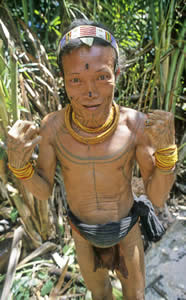 |
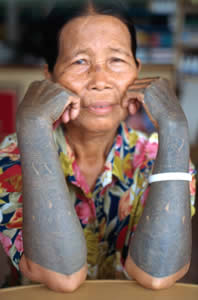 |
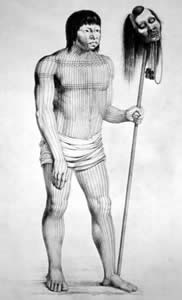 |
The intricate tattoos that appear on
the wrists of the Mentawai people of
Siberut Island, Indonesia are called
ngalou or "beads," but this word
also means "talisman." Like the
Kayan lukut tattoo of Borneo they
"tie in" the soul and keep it close
to the body. The rosettes tattooed
on the shoulders of men (sepippurat)
like shaman Aman Lau Lau (pictured
here) symbolize that evil should
bounce off their bodies like
raindrops from a flower. Photograph
© Lars Krutak 2009-2007. |
Kayan woman with hornbill,
"shoots of bamboo", "guardian
spirits," "dragon-dog," and tuba
root motifs that are all believed to
repel evil spirits. Floral imagery,
symbolizing spiritual powers and
relationships, permeates every facet
of Kayan life. Plants are regarded
as a major kind of living thing,
sharing the same fundamental
properties of life and death as
humans. Photograph © Lars Krutak
2009-2002. |
Full-body tattoos of a Mundurucú warrior with head trophy, ca. 1810. For these dwellers of the Brazilian Amazon, mythology states that their tattoos were given to them by their Creator god who had several avian characteristics. Tattooing for both men and women consisted of fine, widely spaced parallel lines applied vertically on limbs and torso, each motif reminiscent of an abstract series of long bird plumes enveloping the body. Human head trophies were believed to please the "spirit mothers" of the game animals thereby increasing the yield of the hunt and making game more tractable to the hunter. |
Buddhist monks in Thailand, Cambodia, Myanmar, and Laos utilize tools that resemble a sharp two-foot long metal skewer split at one end about two inches to form a needle-sharp pronged tip. The space created between the two needle tips acts as a reservoir to hold the tattoo pigment. These tools look much like a shish-kabob used to barbeque meat and vegetables on the grill. In Thailand, each tattoo is created by a master monk called an arjan. The inks that the monks use are personal recipes, and some are thought to have special "protective" qualities due to their unusual and magical ingredients. For example, some arjans use sandalwood, steeped in herbs or white sesame oil. Oil extracted from wild animals such as elephants in must, galls of tiger, bear and even cobra venom or the chin fat from a corpse are said to be used. Others mentioned that the exfoliated skin of a revered arjan was added to Chinese ink mixed with holy water to make their tattoo pigments. In these cases, it is believed the tattoo thus created from such an ink would cause those people who interact with the wearer to behave as if they were in the presence of a monk; that is, the tattoo would cause them to be somewhat reverent and treat the bearer of the tattoo with respect, among other things.
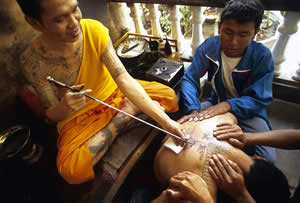 |
|
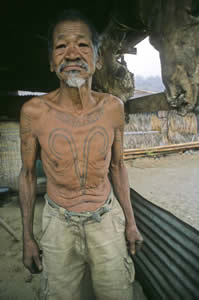 |
Before a Buddhist tattoo master or
arjan gives a tattoo, he must first
read your aura to determine what
design you need. Magical tattoos of
this type have power because they
not only draw on the power of the
tattooist, but also his mentors, and
the Buddha and his teachings. These
are all sources of power (kung). In
this way, Thais who follow Buddhism
operate with a set of assumptions
about the nature of the world, the
beings and forces within it, and the
ways these are related. These
beliefs form an integrated system of
ideas and propositions that they use
to interpret the world and organize
their daily actions. In some cases,
enemies can be turned into friends
with specific tattoos, while others
provide their owners with personal
protection, commanding and
attractive speech, adding to a
person's sacred virtue.
Photograph ©
Lars Krutak 2009. |
|
A Khiamniungen Naga warrior from the
Myanmar/India border with "tiger
chest" tattoo. His V-shaped torso
markings not only indicate that he
is a successful headhunter, but that
he could become "tiger-like" when he
struck down his enemies. Photograph
© Lars Krutak 2009-2007. |
|
|
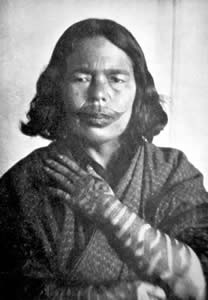
Ainu woman of Japan with bold facial
and forearm tattoos that worked to
repel evil spirits from entering her
body. The Ainu also practiced
medicinal forms of tattooing to
relieve rheumatism. The last Ainu
woman with tattooing died in 1998.
Photograph ca. 1900.
|
The Art of Magical Tattoos
For thousands of years tattooing has been as much of a statement of worldviews in which humans, nature, and the supernatural landscape united as it has been an interlaced fabric that documents a range of ideas about the sacred geography of the skin - our most natural canvas. Tattooed images reveal a close relationship between humans and the rest of nature, and in the cosmology of the tribal tattooist humanity was thought of as an integral part of life's web on every level of existence. In the animistic universe, natural and supernatural forces were propitiated, cajoled, and appealed to for the benefit of humankind, because indigenous peoples sought to acquire access to the power of various animals, spirits, and the ancestors. But more than just skin deep symbols tattoos established visible linkages between these spiritual and natural domains by tapping into them, allowing the body to escape into a world where there was nothing but the magical essence of things detached from the here and now.
Museum photo gallery of these images may
be seen here.
|

